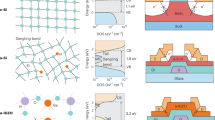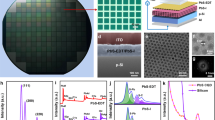Abstract
Image sensors made using silicon complementary metal–oxide–semiconductor technology can be found in numerous electronic devices and typically rely on pinned photodiode structures. Photodiodes based on thin films can have a high absorption coefficient and a wider wavelength range than silicon devices. However, their use in image sensors has been limited by high kTC noise, dark current and image lag. Here we show that thin-film-based image sensors with a pinned photodiode structure can have comparable noise performance to a silicon pinned photodiode pixel. We integrate either a visible-to-near-infrared organic photodiode or a short-wave infrared colloidal quantum dot photodiode with a thin-film transistor and silicon readout circuitry. The thin-film pinned photodiode structures exhibit low kTC noise, suppressed dark current, high full-well capacity and high electron-to-voltage conversion gain, as well as preserving the benefits of the thin-film materials. An image sensor based on the organic absorber has a quantum efficiency of 54% at 940 nm and read noise of 6.1e–.
This is a preview of subscription content, access via your institution
Access options
Access Nature and 54 other Nature Portfolio journals
Get Nature+, our best-value online-access subscription
$29.99 / 30 days
cancel any time
Subscribe to this journal
Receive 12 digital issues and online access to articles
$119.00 per year
only $9.92 per issue
Buy this article
- Purchase on Springer Link
- Instant access to full article PDF
Prices may be subject to local taxes which are calculated during checkout





Similar content being viewed by others
Data availability
The data that support the plots within this paper and other findings of this study are available from the corresponding author upon reasonable request.
References
Rand, B. P. et al. The impact of molecular orientation on the photovoltaic properties of a phthalocyanine/fullerene heterojunction. Adv. Funct. Mater. 22, 2987–2995 (2012).
Georgitzikis, E. et al. Integration of PbS quantum dot photodiodes on silicon for NIR imaging. IEEE Sens. J. 20, 6841–6848 (2020).
Georgitzikis, E. et al. Optimization of charge carrier extraction in colloidal quantum dots short-wave infrared photodiodes through optical engineering. Adv. Funct. Mater. 28, 1804502 (2018).
Leemans, J. et al. Colloidal III–V quantum dot photodiodes for short‐wave infrared photodetection. Adv. Sci. 9, 2200844 (2022).
Ackerman, M. M., Tang, X. & Guyot-Sionnest, P. Fast and sensitive colloidal quantum dot mid-wave infrared photodetectors. ACS Nano 12, 7264–7271 (2018).
Li, Z. et al. Halide perovskites for high-performance X-ray detector. Mater. Today 48, 155–175 (2021).
Nishimura, K. et al. An 8K4K-resolution 60 fps 450ke–-saturation-signal organic-photoconductive-film global-shutter CMOS image sensor with in-pixel noise canceller. In 2018 IEEE International Solid-State Circuits Conference (ISSCC) 82–84 (IEEE, 2018).
Nishimura, K. et al. Advanced features of layered-structure organic-photoconductive-film CMOS image sensor: over 120 dB wide dynamic range function and photoelectric-conversion-controlled global shutter function. Jpn. J. Appl. Phys. 57, 1002B4 (2018).
Basiricò, L. et al. Direct X-ray photoconversion in flexible organic thin film devices operated below 1 V. Nat. Commun. 7, 13063 (2016).
van Breemen, A. J. J. M. et al. Curved digital X-ray detectors. npj Flex. Electron. 4, 22 (2020).
Tsai, H. et al. A sensitive and robust thin-film X-ray detector using 2D layered perovskite diodes. Sci. Adv. 6, eaay0815 (2020).
Goossens, S. et al. Broadband image sensor array based on graphene–CMOS integration. Nat. Photon. 11, 366–371 (2017).
Gregory, C., Hilton, A., Violette, K. & Klem, E. J. D. 66‐3: invited paper: colloidal quantum dot photodetectors for large format NIR, SWIR, and eSWIR imaging arrays. SID Symp. Dig. Tech. Pap. 52, 982–986 (2021).
Pejovic, V. et al. Infrared colloidal quantum dot image sensors. IEEE Trans. Electron Devices 69, 2840–2850 (2022).
Steckel, J. S. et al. 1.62 µm global shutter quantum dot image sensor optimized for near and shortwave infrared. In 2021 IEEE International Electron Devices Meeting (IEDM) 23.4.1–23.4.4 (IEEE, 2021).
Weckler, G. P. Operation of p-n junction photodetectors in a photon flux integrating mode. IEEE J. Solid-State Circuits 2, 65–73 (1967).
Dyck, R. H. & Weckler, G. P. Integrated arrays of silicon photodetectors for image sensing. IEEE Trans. Electron Devices 15, 196–201 (1968).
Teranishi, N., Kohono, A., Ishihara, Y., Oda, E. & Arai, K. No image lag photodiode structure in the interline CCD image sensor. In 1982 International Electron Devices Meeting 324–327 (IRE, 1982).
Fossum, E. R. CMOS image sensors: electronic camera-on-a-chip. IEEE Trans. Electron Devices 44, 1689–1698 (1997).
Chamberlain, S. G. Photosensitivity and scanning of silicon image detector arrays. IEEE J. Solid-State Circuits 4, 333–342 (1969).
Fry, P. W., Noble, P. J. W. & Rycroft, R. J. Fixed-pattern noise in photomatrices. IEEE J. Solid-State Circuits 5, 250–254 (1970).
Fossum, E. R. Active pixel sensors: are CCDs dinosaurs? in Charge-Coupled Devices and Solid State Optical Sensors III Vol. 1900 (ed Blouke, M. M.) 2–14 (SPIE, 1993).
Fossum, E. R. & Hondongwa, D. B. A review of the pinned photodiode for CCD and CMOS image sensors. IEEE J. Electron Devices Soc. 2, 33–43 (2014).
Fossum, E. R., Mendis, S. & Kemeny, S. E. Active pixel sensor with intra-pixel charge transfer. US patent 5,471,515 (1995).
Stephan, B. et al. A vertically integrated high resolution active pixel image sensor for deep submicron CMOS processes. In Proc. 1999 IEEE Workshop on Charge-Coupled Devices and Advanced Image Sensors 64 (1999).
Schulze Spuentrup, J. D. et al. Thin film on CMOS active pixel sensor for space applications. Sensors 8, 6340–6354 (2008).
Lee, J. et al. Imaging in short-wave infrared with 1.82 μm pixel pitch quantum dot image sensor. In 2020 IEEE International Electron Devices Meeting (IEDM) 16.5.1–16.5.4 (IEEE, 2020).
Blanksby, A. J., Loinaz, M. J., Inglis, D. A. & Ackland, B. D. Noise performance of a color CMOS photogate image sensor. In International Electron Devices Meeting, IEDM Technical Digest 47, 205–208 (IEEE, 1997).
Arora, H. et al. Amorphous indium-gallium-zinc-oxide as electron transport layer in organic photodetectors. Appl. Phys. Lett. 106, 143301 (2015).
Janesick, J. R., Elliott, T., Collins, S. & Blouke, M. M. Scientific charge-coupled devices. Opt. Eng. 26, 692–714 (1987).
Voznyy, O. et al. A charge-orbital balance picture of doping in colloidal quantum dot solids. ACS Nano 6, 8448–8455 (2012).
Pejović, V. et al. Photodetectors based on lead sulfide quantum dot and organic absorbers for multispectral sensing in the visible to short‐wave infrared range. Adv. Funct. Mater. 32, 2201424 (2022).
Bi, Y. et al. Infrared solution-processed quantum dot solar cells reaching external quantum efficiency of 80% at 1.35 µm and Jsc in excess of 34 mA cm−2. Adv. Mater. 30, 1704928 (2018).
Kramer, I. J. et al. Efficient spray-coated colloidal quantum dot solar cells. Adv. Mater. 27, 116–121 (2015).
Choi, H. T. et al. Zero-dimensional PbS quantum dot-InGaZnO film heterostructure for short-wave infrared flat-panel imager. ACS Photon. 7, 1932–1941 (2020).
Xu, Y. & Theuwissen, A. J. P. Image lag analysis and photodiode shape optimization of 4T CMOS pixels. In Proc. International Image Sensor Workshop 153–157 (2013).
Belmonte, A. et al. Capacitor-less, long-retention (>400s) DRAM cell paving the way towards low-power and high-density monolithic 3D DRAM. In 2020 IEEE International Electron Devices Meeting (IEDM) 28.2.1−28.2.4 (IEEE, 2020).
Han, L., Yao, S. & Theuwissen, A. J. P. A charge transfer model for CMOS image sensors. IEEE Trans. Electron Devices 63, 32–41 (2016).
Young Chan, K. et al. 1/2-inch 7.2 Mpixel CMOS image sensor with 2.25/spl mu/m pixels using 4-shared pixel structure for pixel-level summation. In 2006 IEEE International Solid State Circuits Conference—Digest of Technical Papers 39, 1994–2003 (IEEE, 2006).
Kim, H. et al. 5.6 A 1/2.65in 44 Mpixel CMOS image sensor with 0.7 µm pixels fabricated in advanced full-depth deep-trench isolation technology. In 2020 IEEE International Solid-State Circuits Conference—(ISSCC) 104–106 (IEEE, 2020).
Mori, M., Katsuno, M., Kasuga, S., Murata, T. & Yamaguchi, T. A 1/4in 2 M pixel CMOS image sensor with 1.75 transistor/pixel. In 2004 IEEE International Solid-State Circuits Conference (IEEE Cat. No. 04CH37519) 47, 110–111 (IEEE, 2003).
Kim, J. H. et al. Detailed characterization of short-wave infrared colloidal quantum dot image sensors. IEEE Trans. Electron Devices 69, 2900–2906 (2022).
Huggett, A., Silsby, C. & Cami, S. A dual-conversion-gain video sensor with dewarping and overlay on a single chip. In 2009 IEEE International Solid-State Circuits Conference—Digest of Technical Papers 52–53,53a (IEEE, 2009).
Oh, Y. et al. A 0.8 μm nonacell for 108 megapixels CMOS image sensor with FD-shared dual conversion gain and 18,000e– full-well capacitance. In 2020 IEEE International Electron Devices Meeting (IEDM) 16.2.1–16.2.4 (IEEE, 2020).
Togashi, H. et al. Three-layer stacked color image sensor with 2.0-μm pixel size using organic photoconductive film. In 2019 IEEE International Electron Devices Meeting (IEDM) 16.6.1–16.6.4 (IEEE, 2019).
Allen, M., Bessonov, A. & Ryhänen, T. 66‐4: invited paper: graphene enhanced QD image sensor technology. SID Symp. Dig. Tech. Pap. 52, 987–990 (2021).
Liu, J. et al. A near-infrared colloidal quantum dot imager with monolithically integrated readout circuitry. Nat. Electron. 5, 443–451 (2022).
Funatsu, R. et al. A 33 Mpixel 60 fps CMOS image sensor with 32-column shared high-speed column-parallel SAR ADCs. In 2015 IEEE International Solid-State Circuits Conference—(ISSCC) Digest of Technical Papers 58, 1–3 (IEEE, 2015).
Oike, Y. et al. 8.3 M-pixel 480 fps global-shutter CMOS image sensor with gain-adaptive column ADCs and chip-on-chip stacked integration. IEEE J. Solid-State Circuits 52, 985–993 (2017).
Okada, C. et al. A 50.1-Mpixel 14-bit 250-frames/s back-illuminated stacked CMOS image sensor with column-parallel kT/C-canceling S&H and ΔΣADC. IEEE J. Solid-State Circuits 56, 3228–3235 (2021).
Acknowledgements
We would like to acknowledge the support from the Mitsubishi Chemical Corporation for providing the organic semiconductor materials used in this study.
Author information
Authors and Affiliations
Contributions
J.L. and E.G. designed, performed and analysed the experiments. P.H., P.E.M. and K.M. analysed the experiments. N.P. and F.D.R. designed the experiments. M.J. and J.H.K. performed the experiments. Y.H., A.B.S., D.C., V.P. and G.U. performed the photodiode analysis and fabrication. N.C., R.P., Y.L. and G.K. performed the fabrication. All authors have reviewed the paper.
Corresponding author
Ethics declarations
Competing interests
The authors declare no competing interests.
Peer review
Peer review information
Nature Electronics thanks Konstantin Stefanov and the other, anonymous, reviewer(s) for their contribution to the peer review of this work.
Additional information
Publisher’s note Springer Nature remains neutral with regard to jurisdictional claims in published maps and institutional affiliations.
Supplementary information
Supplementary Information
Supplementary Figs. 1–12.
Rights and permissions
Springer Nature or its licensor (e.g. a society or other partner) holds exclusive rights to this article under a publishing agreement with the author(s) or other rightsholder(s); author self-archiving of the accepted manuscript version of this article is solely governed by the terms of such publishing agreement and applicable law.
About this article
Cite this article
Lee, J., Georgitzikis, E., Hermans, Y. et al. Thin-film image sensors with a pinned photodiode structure. Nat Electron 6, 590–598 (2023). https://doi.org/10.1038/s41928-023-01016-9
Received:
Accepted:
Published:
Issue Date:
DOI: https://doi.org/10.1038/s41928-023-01016-9



